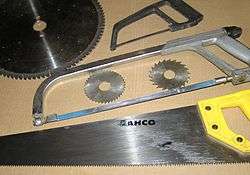zāģis
Latvian

Zāģi
Alternative forms
- (dialectal form) zāgs
Etymology
Borrowed from Middle Low German sage or Middle Dutch zage (cf. German Säge, Dutch zaag). First mentioned in 17th-century dictionaries.[1]
Pronunciation
- IPA(key): [zāːɟis]
Noun
zāģis m (2nd declension)
- saw (a tool with a sharp, usually toothed, blade, used for cutting wood, metal and other hard substances)
- dārza, zaru zāģis ― garden, pruning saw
- baļķu zāģis ― log saw
- rokas zāģis ― hand saw
- elektriskais zāģis ― electric saw
- loka zāģis, lokzāģis ― circular saw
- zāģa zobis ― saw teeth
- zāģu skaidas ― sawdust
- vīlēt zāģi ― to sharpen (lit. to file) the saw teeth
- tēvs bijis namdaris, staigājis ar cirvi un zāģi pār plecu, ģimenei maizes riecienu pelnīdams ― father was a carpenter, walking with an ax and a saw over (his) shoulder, earning the families
- saw (a specialized tool for cutting a specific kind of hard object or substance)
- kaulu zāģis ― bone saw
- diamanta zāģis ― diamond saw
- viņš radījis vairāk nekā divdesmit jaunu ķirurģisku instrumentu, no kuriem īpaši jāatzīmē tā sauktais Šimanovska rezekcijas zāģis ― he has shown more than twenty new surgical instruments, most notably the so-called Šimanovskis' resection saw
Declension
Declension of zāģis (2nd declension)
References
- Karulis, Konstantīns (1992), “zāģis”, in Latviešu Etimoloģijas Vārdnīca (in Latvian), Rīga: AVOTS, →ISBN}
This article is issued from
Wiktionary.
The text is licensed under Creative
Commons - Attribution - Sharealike.
Additional terms may apply for the media files.